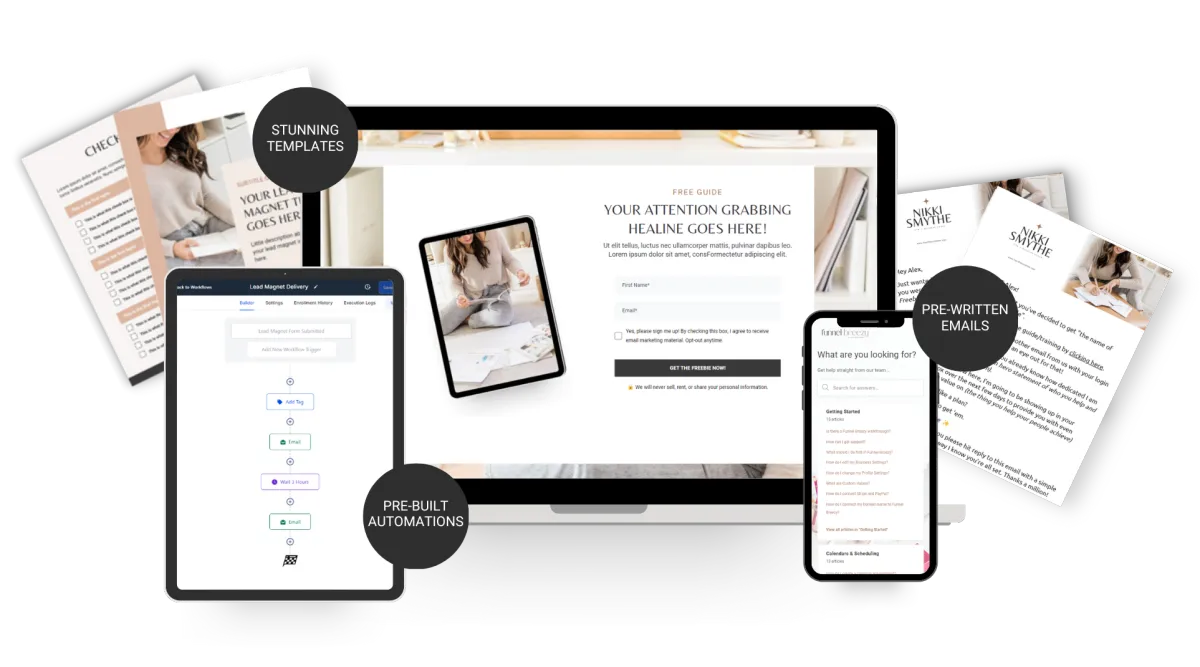The Marketing Map: 8 Steps to Get Your Message Out to the World
Starting your own business can be incredibly exciting—and a bit daunting. If you’re a woman with a dream of launching a service-based business, learning how to create online courses can help you achieve your financial success.
Here are eight actionable steps you should take for building a marketing map in your business!👊
1. Define Your Core Message
Action: Clarify the central message that represents your brand and your offerings. Your message should communicate what sets you apart and how you provide solutions to your audience’s problems.
Why: A well-defined message helps customers quickly understand your value proposition and why they should choose your brand over competitors. It acts as the backbone of all your marketing efforts, from content to communication.
Your core message is what ties all your marketing efforts together. It should be concise but impactful, explaining who you are, what you offer, and why it matters to your audience. Consistency is key—this message needs to resonate across all platforms, from social media to email campaigns, ensuring that your audience always knows what to expect from you. Refining this message not only makes your marketing more cohesive but also helps you differentiate your brand in a crowded marketplace. Take time to craft a message that reflects your values and speaks directly to the needs of your ideal customers.
2. Identify Your Ideal Customer
Action: Develop a detailed profile of your ideal customer, including demographic data, behavioral traits, pain points, challenges, and desired outcomes. Research their preferences and habits.
Why: Understanding your audience helps you craft marketing that speaks directly to their needs, making your content and offers more appealing and targeted, which increases conversions.
Getting clear on who your ideal customer is ensures that your marketing resonates with the right people. When you understand their pain points, struggles, and desires, you can tailor your messaging, products, and content to align with what they are searching for. For example, if your audience is mostly professionals in a particular industry, your messaging should reflect their specific challenges and offer tailored solutions. By knowing your audience deeply, you’ll also be able to choose the right marketing channels, ensuring your content reaches them where they are most active—whether that’s through social media, email, or industry-specific platforms.
3. Build a Content Calendar
Action: Create a comprehensive content calendar that outlines the topics, formats, and platforms for your posts, emails, and other content. Schedule content regularly to maintain consistency.
Why: A content calendar keeps you organized, ensures consistency, and prevents last-minute content creation, all while building momentum over time with regular audience engagement.
Having a content calendar allows you to plan, produce, and distribute your marketing content in a consistent and organized way. By outlining your content in advance, you can make sure that each piece supports your broader marketing goals—whether that’s nurturing leads, driving conversions, or increasing brand awareness. It also enables you to diversify your content (videos, blogs, social posts) and distribute it across different channels at the right times. Consistency is key in building trust and authority with your audience. By maintaining a steady stream of content, you stay top-of-mind and build stronger relationships with potential customers.
4. Automate Lead Generation Systems
Action: Set up automated lead capture systems, such as landing pages with opt-in forms, email sequences, and CRM tools that collect, track, and manage leads automatically.
Why: Automated lead generation ensures that your business consistently captures and nurtures leads, providing a steady flow of potential customers without manual intervention.
Automated lead generation is a game changer when it comes to growing your business efficiently. Using landing pages, email opt-ins, and follow-up email sequences, you can build a system that works around the clock to collect and nurture leads, even when you’re not actively managing it. For instance, offering a valuable lead magnet (e.g., a free eBook or webinar) in exchange for an email address can attract high-quality leads who are genuinely interested in what you offer. Automation tools like The Business Blender can help ensure that no lead slips through the cracks, allowing you to nurture prospects over time and move them through your sales funnel seamlessly.
5. Leverage Social Media Marketing
Action: Develop a strategy for consistent engagement on social media platforms. Use a mix of organic posts, stories, paid advertising, and interactive content to engage with your audience.
Why: Social media amplifies your message, helps you build relationships with your audience, and drives traffic to your website or offers, ultimately increasing visibility and conversions.
Social media marketing is one of the most effective ways to connect with your audience in real time. By posting regularly and engaging with your audience, you can build a community around your brand. Social platforms also allow you to share stories, testimonials, and behind-the-scenes content that humanizes your brand, making it easier for potential customers to relate to you. Combining organic content with paid ads can boost your visibility even further, targeting specific audiences based on demographics, interests, and behaviors. To maximize the impact of your efforts, track your social media performance through metrics like engagement rates, click-throughs, and conversions, and adjust your strategy as needed.
6. Track Performance with Analytics
Action: Use analytics tools like Google Analytics, email insights, and social media metrics to track the performance of your campaigns. Set up KPIs (key performance indicators) and monitor them regularly.
Why: Tracking your results allows you to make data-driven decisions, optimize your campaigns, and allocate resources to what’s working best, which improves ROI.
Data is your best friend when it comes to optimizing your marketing efforts. By regularly reviewing your performance metrics, you can identify which campaigns and channels are driving the best results. Are certain types of content generating more leads? Are your social media ads converting at a higher rate than your email campaigns? Metrics such as website traffic, conversion rates, and customer acquisition costs will give you valuable insights into what’s working and where improvements can be made. With tools like Google Analytics, you can also track visitor behavior on your website, helping you tweak landing pages and calls to action to maximize conversions.
7. Nurture Leads with Automated Emails
Action: Build automated email sequences that deliver valuable content to your leads over time, nurturing them and moving them through the sales funnel toward a purchase decision.
Why: Email automation allows you to maintain ongoing communication with leads without manual effort, keeping your brand top-of-mind and improving conversion rates.
Nurturing leads with an email sequence ensures that they remain engaged with your business over time. By delivering personalized, valuable content directly to their inbox, you build trust and keep them interested in your products or services. Automated emails can be used to onboard new leads, offer tips or tutorials, and even present exclusive promotions to encourage purchases. Tools like The Business Blender allow you to set up complex sequences that respond to lead behavior (e.g., sending different emails based on whether a lead clicked a link or made a purchase), ensuring a customized experience for each recipient.
8. Scale and Optimize Your Strategy
Action: Regularly assess the success of your marketing efforts, scaling the strategies that deliver the highest ROI and making improvements where needed. Continue to refine your approach based on performance data.
Why: Scaling successful strategies allows you to maximize results, while continuous optimization ensures your marketing adapts to changing trends and audience needs, keeping your business competitive.
The final step in any marketing strategy is scaling what works and continually optimizing for better results. If you’ve found a particular ad campaign, email sequence, or social media strategy that’s generating leads and sales, it’s time to double down on it. Increase your ad spend, create more content, or add new lead magnets to capitalize on that success. At the same time, don’t forget to optimize. Use performance data to tweak underperforming strategies, whether that means adjusting messaging, targeting, or timing. Marketing trends and consumer behaviors shift over time, so regularly review your strategy to ensure it’s as effective as possible.
The Marketing Map Checklist:
Define your brand’s core message and ensure consistency across all channels.
Identify your ideal customer with a detailed profile.
Build a comprehensive content calendar to maintain consistent engagement.
Set up automated lead generation systems (opt-ins, funnels, etc.).
Develop a social media strategy (organic content + paid ads).
Automate lead nurturing with email sequences.
Track your marketing performance using analytics tools.
Optimize and refine your marketing strategies based on performance data.
Regularly review and update your content and messaging to stay relevant.
Have patience with yourself as you learn!
Download Our Free Create Your Client Journey Guide


Here's some stuff
Here's some stuff
Here's some stuff
Here's some stuff
Here's some stuff
Here's some stuff
Here's some stuff
Here's some stuff
Here's some stuff
Here's some stuff
Here's some stuff
Here's some stuff
© 2025 Start Up Central, LLC
DBA The Business Blender
